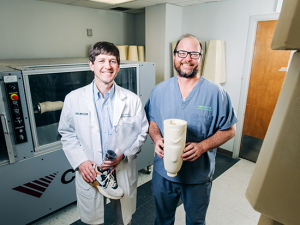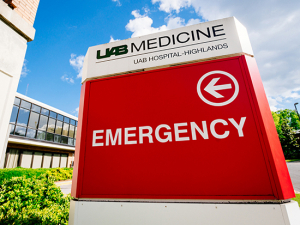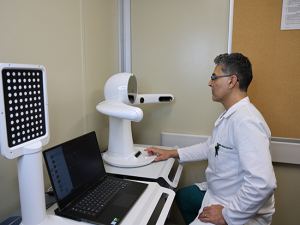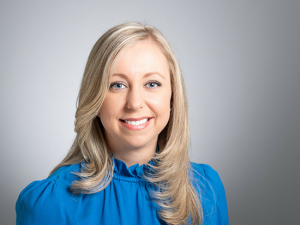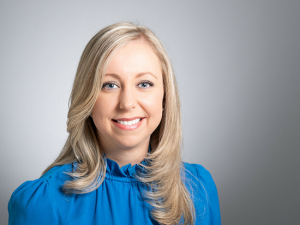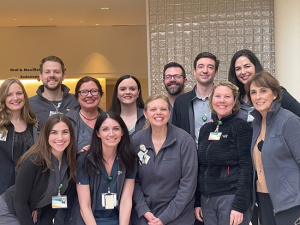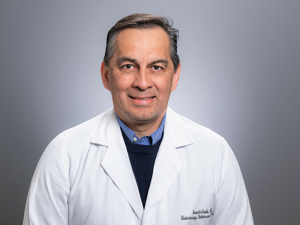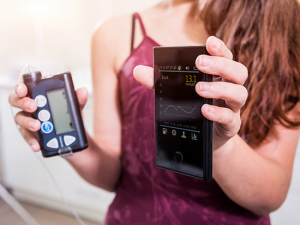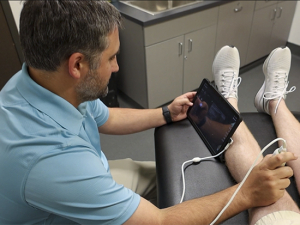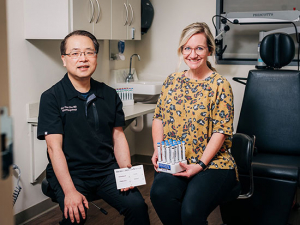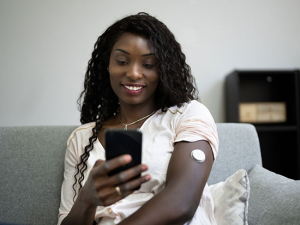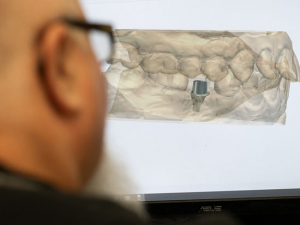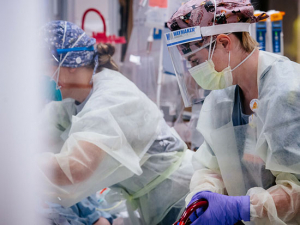 The remote patient monitoring program gives high-risk patients cellular-enabled weight scales, blood pressure cuffs and/or glucose monitors to take home. Once a reading is taken on a device, the number automatically populates in the patient’s chart and electronic health portal.Each year, thousands of people arrive at UAB Medicine’s emergency department with potentially life-threatening complications from diabetes, congestive heart failure and high blood pressure.
The remote patient monitoring program gives high-risk patients cellular-enabled weight scales, blood pressure cuffs and/or glucose monitors to take home. Once a reading is taken on a device, the number automatically populates in the patient’s chart and electronic health portal.Each year, thousands of people arrive at UAB Medicine’s emergency department with potentially life-threatening complications from diabetes, congestive heart failure and high blood pressure.
Over the past 12 months or so, an existing UAB Medicine telemedicine program, led by the UAB eMedicine team, has ramped up a dramatic response. More than 1,000 patients have enrolled in a cutting-edge remote patient monitoring program that gives high-risk patients cellular-enabled blood pressure cuffs, glucose monitors and/or weight scales to take home. Participants don’t need to have internet access, which is not always available or affordable in many parts of the state. Instead, once a reading is taken on a device, the number automatically populates in the patient’s chart and electronic health portal.
Significant benefits for patients
“Remote patient monitoring is a game changer for health care and provides an easy and reliable way to get patients’ health under control the fastest way possible,” said Eric Wallace, M.D., medical director for UAB eMedicine. “Having access to health care providers daily and providing validated measurements to everyone on your health care team daily is revolutionary, and we are already seeing significant benefits for our patients.”
Patients in the program agree to take readings at least 16 calendar days per month; this data is instantly, securely transmitted to UAB Medicine’s electronic medical record system, where it is monitored by algorithms that flag onsite UAB Medicine nurses if numbers are trending negatively. In emergency situations, the nurses page the patient’s managing provider in case a higher acuity escalation plan is needed.
Patients love the program, says Darby Davenport, manager of operations for the remote patient monitoring program in UAB eMedicine. Nurses aren’t simply managing phones and calling in emergencies — they provide individualized care to patients from the comfort of their home. Likewise, patients have the nurses’ numbers, too, in case questions or concerns arise. “The technology is great, but another huge benefit of the program is access to nursing,” Davenport said. “Patients are monitored closely and bi-directionally. They are receiving individualized care every day in their home, which is improving outcomes.”
“Remote patient monitoring is a game changer for health care and provides an easy and reliable way to get patients’ health under control the fastest way possible."
Helping patients avoid unnecessary trips to the ED
Patients with diabetes, congestive heart failure and high blood pressure account for a hefty percentage of patient visits each year at UAB, Davenport says. But the data their care teams must work with is usually based on readings taken at clinic visits and maybe some self-reporting, which can sometimes be unreliable. “There is a lot of room for ambiguity there,” Davenport said. “Instead, when you are in the program, you have this huge history of data points and the team can piece it all together: when there are spikes, when things are better and so on to expedite, improve and create a maintainable action plan.”
That opens the way for practical, real-life conversations that help patients not only avoid unnecessary trips to the emergency room but can change their health for the better. “On Thanksgiving Day, we all may not follow a specific diet,” Davenport said. “Of course, your blood sugar and blood pressure is up; of course you have gained more than five pounds in a week. That’s okay — you should be enjoying the holiday with your loved ones. Because of the relationships that our patients develop with their nurses, they are able to talk about it beforehand. They’ll say, ‘Thanksgiving is coming up; we know you are going to want to eat Thanksgiving dinner with your family and enjoy those special dishes. Here are some realistic strategies we can impose throughout the week that will allow you to enjoy your time with family while keeping your chronic care needs under control. That will help you avoid those spikes.’”
Personal and financial benefits
Although the program is still analyzing outcomes data, patients are benefitting, with average declines in systolic blood pressure of 10+ mmHg, Davenport said. “That is huge; going from a systolic reading of 180 to the 160s and 150s is a major change in the patient’s overall health.” The savings to the entire state’s overloaded health care system from reduced emergency visits is clearly a major financial benefit as well, Davenport adds.
“Everyone on this team has been working so hard, because we see what it is doing and are so passionate about the people we are helping,” Davenport said. “I didn’t realize exactly what we had, though, until I went to a national remote patient monitoring conference earlier this year.” After Davenport’s presentation, representatives from some of the most recognized health systems came up to say “they were very impressed with our experience,” she recalled. “The room was filled to capacity and there was a line of people afterward leaving me their business cards. For many of these organizations, their goal is to enroll 50 people a year. We have 600-plus patients live with the program at any given time; it’s been painstaking work, but that gave everyone a confidence boost.”
“The technology is great, but another huge benefit of the program is access to nursing. Patients are monitored closely and bi-directionally. They are receiving individualized care every day in their home, which is improving outcomes.”
How to join the program
How can patients join the program? Anyone who is a UAB Medicine patient, lives in Alabama and has a chronic disease that matches the eligibility requirements can join if their doctor feels they would benefit, Davenport said. “I would encourage anyone who meets those criteria to talk to their doctor.” Any UAB Medicine provider can refer a patient to the program through the Cerner electronic health record system, she adds. “If you are an orthopedist and you see a patient with a broken wrist but notice they have high blood pressure, you can refer them,” she said. “The referring provider is just providing the referral. We will identify an appropriate managing provider the patient has previously seen or create a visit with our internal advanced practice provider, [nurse practitioner] Mayumi Oda to manage them during their RPM journey. For any UAB provider, I would say, if you think this might help, or even just wonder if it will help, place the referral. It can’t hurt, and we are willing to do the work on the back end to see if it is a fit and find the patient’s most appropriate care provider to manage.”
The end goal of the remote patient monitoring program is to get patients from an uncontrolled state to a controlled state for their chronic disease, Davenport says. “It’s amazing to hear a nurse say, ‘Hey, Mr. Bill, how was lunch yesterday with your mom?’ or ‘Hi, Mrs. Smith. It’s Francis from the RPM team. How was your grandson’s soccer game last night?’” The RPM program allows for daily interactions with a care team in a way that traditional interactions with a provider cannot do, Davenport explains. The standard of care is a visit with your doctor once every three to six months, but “this care is daily,” she said. “You have someone to talk to who can troubleshoot any issues you are facing and has all the facts. That will lead to a much more sustainable future due to its relational foundation and actually works for the patients regardless of where they live or what the caregiver support from family or friends might be.”
And, slowly, the effect is spreading, Davenport said. “Many of these patients are in rural Alabama, in towns where there isn’t even a stoplight. Everybody knows everybody. And a lot of those people have hypertension, diabetes and congestive heart failure, too. If you see that your friend or family member is getting better, you might start picking up on those healthcare management practices as well. We have heard stories of patients who have spoken with loved ones regarding the program to control their chronic care. They’ll say, ‘My mom or dad or child or friend is struggling with this, too; they had concerns about how realistically this would impact their day-to-day, but now they see my results and have begun adapting similar lifestyle changes as well.”
The work is gratifying for the entire RPM team, Davenport said. “I am so proud of the combined efforts of UAB eMedicine and the Patient Healthcare Coordination Center — they see the difference they are making and everyone is willing to do whatever it takes to help our patients.”
